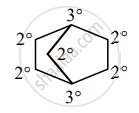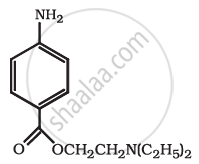Advertisements
Advertisements
प्रश्न
Identify primary, secondary, tertiary and quaternary carbon in the following compound.

उत्तर

APPEARS IN
संबंधित प्रश्न
Draw a formula for the first five members of the homologous series beginning with the given compound.
CH3COCH3
Identify the functional group in the following compound.

Find out all the functional groups present in the following polyfunctional compound.
Penicillin G, a naturally occurring antibiotic.

Identify primary, secondary, tertiary, and quaternary carbon in the following compound.
\[\begin{array}{cc}\ce{CH3}\phantom{..................}\\
|\phantom{....................}\\\ce{CH3 - C - CH - CH2 - CH2 - CH3}\\|\phantom{.....}|\phantom{................}\\
\ce{CH3}\phantom{.}\ce{CH3}\phantom{..............}
\end{array}\]
What is meant by homologous series?
Write the first four members of the homologous series that begins with H-C≡C-H. Also, write down their general molecular formula.
How many cyclic and acyclic isomers are possible for the molecular formula C3H6O?
Describe the classification of organic compounds based on their structure.
Write a note on homologous series.
Write the molecular formula and possible structural formula of the first four members of homologous series of carboxylic acids.
Write the molecular formula of the first six members of homologous series of nitro – alkanes.
The reagent used to confirm the presence of five hydroxyl groups in glucose is ____________.
Identify the pair of organic compounds which belongs to homologous series.
What is the percentage of carbon in urea?
(Atomic mass C = 12, H = 1, N = 14, O = 16)
An organic compound containing carbon, hydrogen and oxygen is soluble in dil. H2SO4 and does not react with sodium metal or KMnO4. When it is heated with HI in excess, a single alkyl halide is obtained. The original compound can be ____________.
Which of the following statements is INCORRECT for the organic compounds which belong to homologous series?
How many 3° carbon atoms are present in 1, 4 dibromo-2-methylpentane?
How many primary, secondary and tertiary carbon atoms respectively are present in isobutane?
A pyranose ring consists of a skeleton of ______.
The correct decreasing order of priority for the functional groups of organic compounds in the IUPAC system of nomenclature is ______.
Identify primary, secondary, tertiary and quaternary carbon in the following compounds.
\[\begin{array}{cc}
\ce{CH3}\phantom{.................}\\
|\phantom{....................}\\
\ce{CH3 - C - CH - CH2 - CH2 - CH3}\\
|\phantom{.....}|\phantom{...............}\\
\ce{CH3}\phantom{..}\ce{CH3}\phantom{.............}
\end{array}\]
Identify the α - carbons in the following species and give the total number of
\[\ce{CH3 -CH2 -\overset{⊕}{C}H -CH2 -CH3}\]
Identify primary, secondary, tertiary and quaternary carbon in the following compound.
\[\begin{array}{cc}
\ce{CH3}\phantom{..................}\\
|\phantom{....................}\\
\ce{CH3 - C - CH - CH2 - CH2 - CH3}\\
|\phantom{....}|\phantom{................}\\
\ce{CH3}\ce{CH3}\phantom{..............}
\end{array}\]
Identify primary, secondary, tertiary and quaternary carbon in the following compound.
\[\begin{array}{cc}
\ce{CH3}\phantom{..................}\\
|\phantom{....................}\\
\ce{CH3 - C - CH - CH2 - CH2 - CH3}\\
|\phantom{....}|\phantom{................}\\
\ce{CH3}\phantom{.}\ce{CH3}\phantom{..............}
\end{array}\]
Identify the α - carbons in the following species and give the total number of α-hydrogen in each.
\[\ce{CH3 - CH2 - \overset{\oplus}{C}H - CH2 - CH3}\]
Identify primary, secondary, tertiary and quaternary carbon in the following compound.
\[\begin{array}{cc}
\ce{CH3}\phantom{.................}\\
|\phantom{....................}\\
\ce{CH3 - C - CH - CH2 - CH2 - CH3}\\
|\phantom{....}|\phantom{................}\\
\ce{CH3}\phantom{.}\ce{CH3}\phantom{..............}
\end{array}\]
